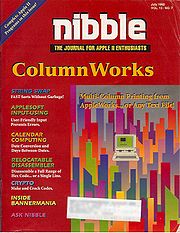
Nibble (magazine)
Encyclopedia

Computer
A computer is a programmable machine designed to sequentially and automatically carry out a sequence of arithmetic or logical operations. The particular sequence of operations can be changed readily, allowing the computer to solve more than one kind of problem...
users with a focus on hobbyist programming
Computer programming
Computer programming is the process of designing, writing, testing, debugging, and maintaining the source code of computer programs. This source code is written in one or more programming languages. The purpose of programming is to create a program that performs specific operations or exhibits a...
. The name
Nibble
In computing, a nibble is a four-bit aggregation, or half an octet...
meant "half a byte" (perhaps in reference to Byte
Byte (magazine)
BYTE magazine was a microcomputer magazine, influential in the late 1970s and throughout the 1980s because of its wide-ranging editorial coverage...
) or "four bits." Its slogan was "The Magazine for Apple II Enthusiasts." Most of the articles incorporated the source code
Source code
In computer science, source code is text written using the format and syntax of the programming language that it is being written in. Such a language is specially designed to facilitate the work of computer programmers, who specify the actions to be performed by a computer mostly by writing source...
of a small to medium-sized utility, application program, or game (each written specifically for the magazine) and a detailed description of how it worked.
The magazine was first published in January 1980 by Mike Harvey. Originally published eight times per year, by 1984 the magazine had attained a popularity that allowed it become a monthly publication. It was published for more than twelve years; the July 1992 issue was the last.
Since typing in the BASIC
BASIC
BASIC is a family of general-purpose, high-level programming languages whose design philosophy emphasizes ease of use - the name is an acronym from Beginner's All-purpose Symbolic Instruction Code....
or hexadecimal
Hexadecimal
In mathematics and computer science, hexadecimal is a positional numeral system with a radix, or base, of 16. It uses sixteen distinct symbols, most often the symbols 0–9 to represent values zero to nine, and A, B, C, D, E, F to represent values ten to fifteen...
listings could be error-prone, the magazine also published checksum tables that, with utilities available from the magazine, helped pinpoint the location of any errors in a reader's own typed-in copy. The programs were also available on disk for a small fee for those who did not want to spend the time to type them in.
A technical highlight of Nibble was a regular column called Disassembly Lines, in which Dr. Sanford Mossberg presented assembly listings he had reverse-engineered from interesting parts of Applesoft BASIC and the DOS to illustrate how they worked. Later Mossberg turned his attention to the Apple IIGS and dissected its Toolbox and operating system as well.
Omnibus editions of the best articles from each year's issues, dubbed Nibble Express, were published annually. The magazine also published other books that repurposed magazine material on various topics, such as games, personal finance programs, and "Apple secrets." Mossberg's Disassembly Lines columns were also collected in four volumes.
Harvey's publishing company, MicroSPARC (later MindCraft), published a number of Apple II programming utilities including an assembler and a BASIC-like set of macros for it. These were sold by mail-order from ads in the magazine. (Trivia: the company changed its name after Sun Microsystems
Sun Microsystems
Sun Microsystems, Inc. was a company that sold :computers, computer components, :computer software, and :information technology services. Sun was founded on February 24, 1982...
bought the name MicroSPARC for a new line of processors.)
A spinoff Macintosh publication, Nibble Mac, was first a section in Nibble and then was published separately. Like the original, Nibble Mac focused on hobbyist programming, notably HyperCard.
Most of the Nibble material, including Nibble Mac, is now available again from the publisher through his Web site.

